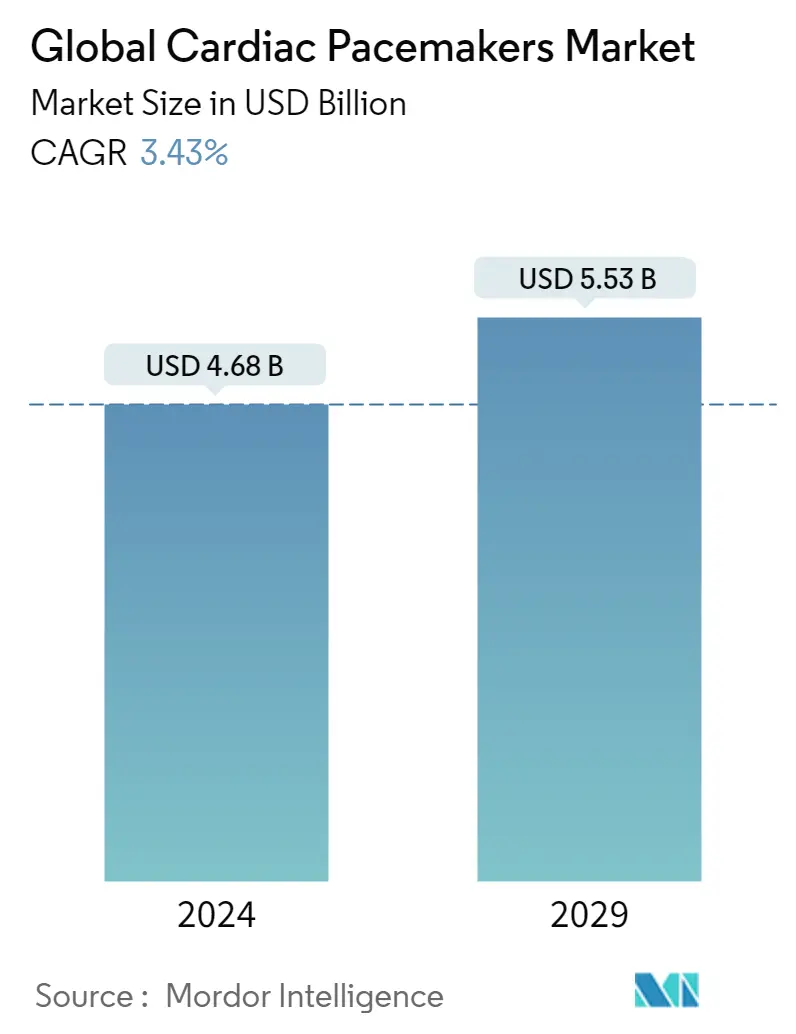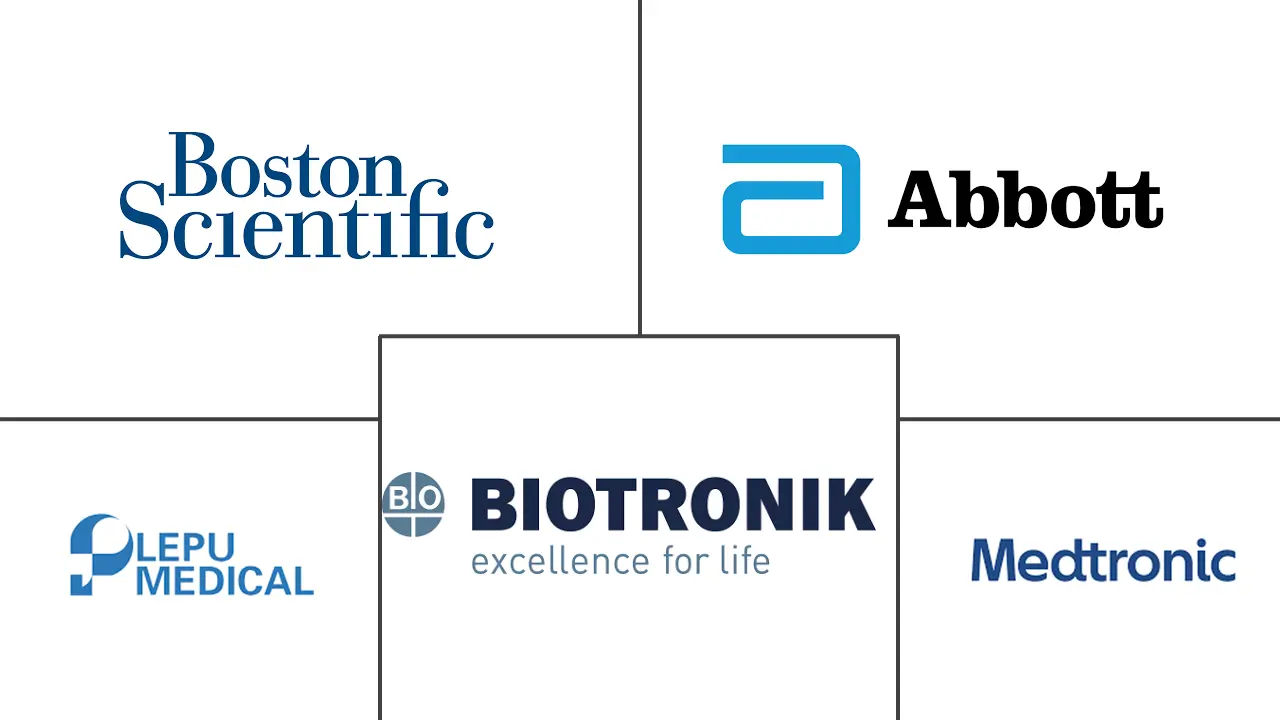Market Size of Global Cardiac Pacemakers Industry

| Study Period | 2019 - 2029 |
| Market Size (2024) | USD 4.68 Billion |
| Market Size (2029) | USD 5.53 Billion |
| CAGR (2024 - 2029) | 3.43 % |
| Fastest Growing Market | Asia Pacific |
| Largest Market | North America |
Major Players
*Disclaimer: Major Players sorted in no particular order |
Cardiac Pacemakers Market Analysis
The Global Cardiac Pacemakers Market size is estimated at USD 4.68 billion in 2024, and is expected to reach USD 5.53 billion by 2029, growing at a CAGR of 3.43% during the forecast period (2024-2029).
The COVID-19 pandemic slowed the growth of the cardiovascular market. Due to the high rate of infection and the lack of treatment, many countries are suffering and continue to carry a heavy burden on their economies and healthcare systems. Many countries had previously shut down and stopped trading with other countries due to travel restrictions, leading to a slowdown for large companies worldwide. The American College of Surgeons and the American Society of Anesthesiologists recommended a continuous reduction in the rate of new cases of COVID-19 14 days before the resumption of special surgery. Also, according to a research article published in Case Reports in Cardiology, 2020, temporary patients undergoing pacemaker transfusion are 2.5 times more likely to acquire COVID-19 infection before the first pacemaker (PPM) injection. Therefore, research suggested that the selection of temporary cardiac care providers increased the risk of long-term associated complications and transmission of infection to healthcare workers. Therefore, the market is expected to see negative growth due to the high risk associated with heart surgery during COVID-19.
The escalation of lifestyle-related disruptions, favorable reimbursement status, increased adult populations, and technological advances are expected to boost the market studied.
According to data from the World Population Prospects: Highlights 2020, approximately 1.5 billion people worldwide will be over 65 by 2050, up from 727 million by 2020. One in four people in Europe and North America will be 65 years or older by 2050. From 143 million in 2019 to 426 million by 2050, the number of people aged 80 and over is expected to triple. Pacing treatment is usually done to treat severe arrhythmia. According to a research article titled "Pacemaker Treatment for Older Patients: Survival and Specific Predicting Limits for One-Centered Experience", published in 2019, the number of older patients receiving pacemakers is growing, and European guidelines do not consider any age limits to installing a pacemaker.
In addition, according to a World Health Organization article published in July 2021, an estimated 17.9 million people worldwide die from heart disease every year, representing 31% of deaths globally, and 85% of these deaths are mainly caused by heart disease and stroke. Therefore, the growing burden of heart disease worldwide and technological advancements in the development of novel pacemakers are expected to boost the cardiovascular market during the forecast period.
Cardiac Pacemakers Industry Segmentation
As per the scope of the report, cardiac pacemakers are medical devices used to deliver electrical pulses to the heart to maintain a normal heart rate. Pacemakers are used to treat patients suffering from heart conditions, such as heart failure and arrhythmias. The cardiac pacemakers market is segmented by type and geography. The market report also covers the estimated market sizes and trends for 17 countries across major regions globally. The report offers the value in USD million for the above-mentioned segments.
| By Type | |||||
| |||||
| External |
| By Geography | ||||||||
| ||||||||
| ||||||||
| ||||||||
| ||||||||
|
Global Cardiac Pacemakers Market Size Summary
The cardiac pacemaker market is poised for steady growth over the forecast period, driven by an increasing prevalence of cardiovascular diseases and advancements in medical technology. The market is experiencing a resurgence after the COVID-19 pandemic, which had previously hindered growth due to the risks associated with heart surgeries during the pandemic. The aging global population, particularly the rise in individuals over 65, is a significant factor contributing to the demand for pacemakers, as this demographic is more susceptible to severe arrhythmias requiring pacing treatment. Technological innovations, such as remote data tracking and MRI-compatible devices, are further propelling market expansion. The implanted cardiac pacemakers segment, including single chamber, dual-chamber, and biventricular devices, is expected to dominate the market due to their growing adoption and the benefits they offer in managing conditions like ventricular dyssynchrony.
North America stands out as the largest regional market, fueled by a high prevalence of cardiovascular diseases and a robust healthcare infrastructure. The region's market growth is supported by the presence of key industry players like Abbott Laboratories and Boston Scientific Corporation, which are actively involved in developing and marketing advanced cardiac devices. The increasing incidence of heart diseases, coupled with the introduction of innovative products, is expected to drive market growth in the United States. The competitive landscape of the cardiac pacemaker market is characterized by a few dominant players, with ongoing developments such as the launch of miniaturized pacemakers and strategic acquisitions aimed at enhancing product offerings and market reach.
Global Cardiac Pacemakers Market Size - Table of Contents
-
1. MARKET DYNAMICS
-
1.1 Market Overview
-
1.2 Market Drivers
-
1.2.1 Rising Prevalence of Lifestyle-related Disorders
-
1.2.2 Rapidly Growing Geriatric Population
-
1.2.3 Advancements in Pacemaker Technology and Minimally Invasive Procedures
-
-
1.3 Market Restraints
-
1.3.1 High Costs Associated with Application and Maintenance
-
1.3.2 Cyber Security Risk Associated with Connected Pacemakers
-
-
1.4 Industry Attractiveness - Porter's Five Forces Analysis
-
1.4.1 Threat of New Entrants
-
1.4.2 Bargaining Power of Buyers/Consumers
-
1.4.3 Bargaining Power of Suppliers
-
1.4.4 Threat of Substitute Products
-
1.4.5 Intensity of Competitive Rivalry
-
-
-
2. MARKET SEGMENTATION (Market Size by Value - USD million)
-
2.1 By Type
-
2.1.1 Implantable
-
2.1.1.1 Single Chamber
-
2.1.1.2 Dual Chamber
-
2.1.1.3 Biventricular
-
-
2.1.2 External
-
-
2.2 By Geography
-
2.2.1 North America
-
2.2.1.1 United States
-
2.2.1.2 Canada
-
2.2.1.3 Mexico
-
-
2.2.2 Europe
-
2.2.2.1 Germany
-
2.2.2.2 United Kingdom
-
2.2.2.3 France
-
2.2.2.4 Italy
-
2.2.2.5 Spain
-
2.2.2.6 Rest of Europe
-
-
2.2.3 Asia-Pacific
-
2.2.3.1 China
-
2.2.3.2 Japan
-
2.2.3.3 India
-
2.2.3.4 Australia
-
2.2.3.5 South Korea
-
2.2.3.6 Rest of Asia-Pacific
-
-
2.2.4 Middle-East and Africa
-
2.2.4.1 GCC
-
2.2.4.2 South Africa
-
2.2.4.3 Rest of Middle-East and Africa
-
-
2.2.5 South America
-
2.2.5.1 Brazil
-
2.2.5.2 Argentina
-
2.2.5.3 Rest of South America
-
-
-
Global Cardiac Pacemakers Market Size FAQs
How big is the Global Cardiac Pacemakers Market?
The Global Cardiac Pacemakers Market size is expected to reach USD 4.68 billion in 2024 and grow at a CAGR of 3.43% to reach USD 5.53 billion by 2029.
What is the current Global Cardiac Pacemakers Market size?
In 2024, the Global Cardiac Pacemakers Market size is expected to reach USD 4.68 billion.

